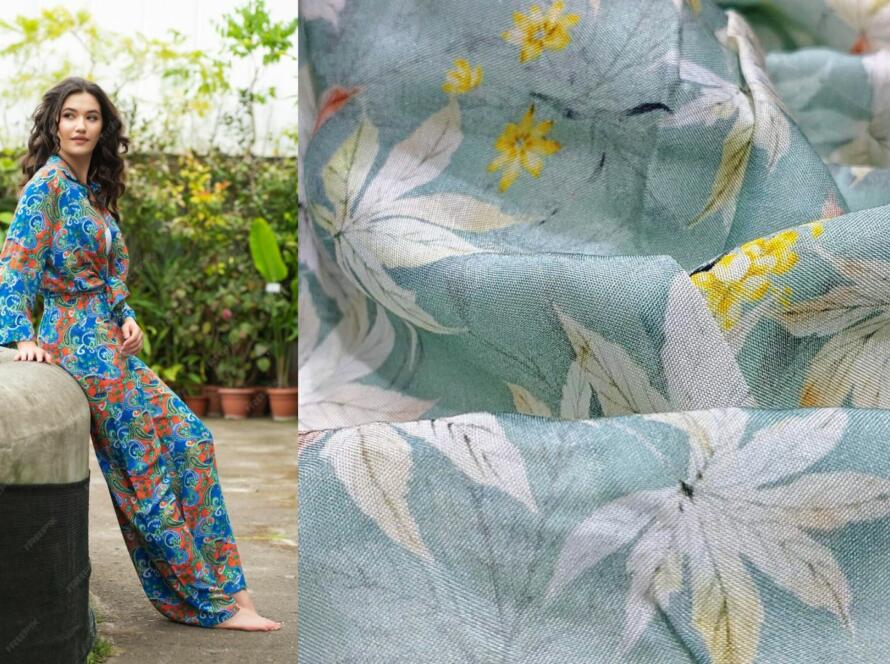India, known as Bharat, is a land where the art of embroidery has flourished for centuries, weaving its intricate threads into the fabric of the nation’s cultural heritage.
“Madhav Fashion is a top embroidery fabric manufacturer in Bharat. Madhav Fashion is expanding the heritage of India throughout the world through its embroidery fabric creations, which are admired by millions of customers, fashion designers, garment manufacturers, boutiques, and fabric wholesalers“
From the majestic Himalayas to the sun-kissed beaches of Goa, India’s diverse landscapes have inspired a multitude of embroidery styles, each reflecting the unique traditions and craftsmanship of its region.
The art of embroidery in Bharat is as varied as the country itself, with each region boasting its own distinctive techniques and motifs. In the northern state of Punjab, Phulkari embroidery adorns fabrics with vibrant floral patterns, symbolizing the joy and exuberance of life. Meanwhile, in the western state of Gujarat, Kutch embroidery dazzles with its intricate mirror work and geometric designs, a testament to the region’s rich textile heritage.
Embroidery in Bharat
One cannot speak of Indian (Bharat) embroidery without mentioning the timeless elegance of Chikankari, a delicate form of white-on-white embroidery originating from the city of Lucknow. Characterized by its fine threadwork and intricate stitches, Chikankari has long been cherished for its ethereal beauty and exquisite craftsmanship, making it a favorite among discerning fashion connoisseurs.

India’s (Bharat) rich history of embroidery extends beyond its borders, with ancient trade routes carrying its prized fabrics to distant lands. The Mughal emperors, known for their love of luxury and opulence, were avid patrons of Indian textiles, further elevating the art of embroidery to new heights of sophistication and refinement.
Today, Indian (Bharatiya) embroidery continues to captivate the world with its timeless allure and craftsmanship. From haute couture runways to humble village workshops, artisans across the country are keeping this ancient tradition alive, infusing modern designs with age-old techniques passed down through generations.
Indian (Bharatiya) embroidery is not merely an art form but a living testament to the country’s rich cultural heritage and artistic legacy. As we admire the intricate stitches and vibrant colors of these embroidered fabrics, let us also pay homage to the skilled artisans who continue to keep this timeless tradition alive, ensuring that India’s rich tapestry of embroidery will endure for generations to come.
1. What is the significance of embroidery in Indian culture?
Embroidery holds a profound significance in Indian culture, serving as a vibrant expression of artistic heritage and tradition. For centuries, embroidery has been intricately woven into the fabric of Indian society, adorning textiles with exquisite designs and motifs that reflect the diverse cultural tapestry of the nation. It serves as a form of storytelling, preserving ancient narratives and symbols passed down through generations. Moreover, embroidery plays a crucial role in economic empowerment, providing livelihoods to countless artisans across the country.

2. How diverse are the embroidery styles in India (Bharat)?
India (Bharat) boasts a rich tapestry of embroidery styles, each originating from different regions and communities, showcasing a diverse range of techniques, motifs, and aesthetics. From the colorful Phulkari of Punjab to the delicate Chikankari of Lucknow, and the intricate Kantha of West Bengal, the variety of embroidery styles in India is truly staggering. Each style is characterized by its unique stitches, patterns, and cultural influences, making Indian embroidery a treasure trove of artistic diversity.
3. What are some notable examples of Indian embroidery techniques?
Indian embroidery techniques encompass a wide array of styles, each with its own unique characteristics and methods. Some notable examples include the dazzling mirror work of Kutch embroidery, the intricate threadwork of Kashmiri embroidery, and the geometric patterns of Sindhi embroidery. Additionally, Zardozi embroidery, known for its use of metallic threads and embellishments, and Bandhani, a tie-dye technique prevalent in Gujarat and Rajasthan, are also highly regarded for their craftsmanship and beauty.
4. How has Indian embroidery influenced global fashion?
Indian embroidery has had a profound impact on the global fashion industry, with designers and fashion houses incorporating its motifs and techniques into their collections. From haute couture runways to ready-to-wear garments, Indian embroidery adds a touch of elegance and exoticism to fashion creations, attracting a global audience drawn to its intricate craftsmanship and cultural richness.

5. What role did historical empires play in the development of Indian embroidery?
Historical empires such as the Mughals played a significant role in shaping the development of Indian embroidery. The Mughal emperors were avid patrons of the arts, and their courtly extravagance fueled the demand for luxurious textiles adorned with intricate embroidery. Under their patronage, Indian artisans flourished, creating masterpieces that blended Persian, Central Asian, and indigenous Indian influences, resulting in a fusion of styles that continues to inspire artisans and designers to this day.
6. How do modern artisans preserve traditional Indian (Bharatiya) embroidery techniques?
Modern artisans are dedicated to preserving traditional Indian embroidery techniques by passing down their knowledge and skills to future generations. Many artisans belong to family lineages with centuries-old traditions, and they undergo rigorous training from a young age to master the intricate stitches and patterns of their craft. Additionally, organizations and NGOs are working to support artisans by providing training programs, design assistance, and access to markets, ensuring that these ancient techniques remain relevant in a rapidly changing world.
7. What are the economic implications of Indian embroidery?
Indian embroidery plays a crucial role in the country’s economy, providing employment opportunities to millions of artisans, particularly women, in rural and marginalized communities. Embroidery has emerged as a sustainable livelihood option for many households, empowering artisans to earn a steady income while preserving their cultural heritage. Moreover, the global demand for Indian embroidered textiles has led to the growth of export-oriented industries, contributing significantly to India’s foreign exchange earnings and economic development.
8. How is Indian embroidery adapting to modern trends and technologies?
While traditional techniques remain at the heart of Indian embroidery, artisans are also embracing modern trends and technologies to stay relevant in today’s market. Many designers are experimenting with innovative materials, combining traditional embroidery with contemporary fabrics and styles to appeal to a wider audience. Additionally, advancements in technology have facilitated the production process, allowing artisans to streamline their workflow and create high-quality embroideries more efficiently.
9. What is the future outlook for Indian embroidery?
Despite the challenges posed by globalization and industrialization, the future outlook for Indian embroidery remains bright. As awareness of sustainable and ethically sourced textiles grows, there is a renewed appreciation for the craftsmanship and authenticity of handcrafted embroideries. With support from government initiatives, NGOs, and conscientious consumers, Indian embroidery is poised to thrive in the digital age, continuing to enchant the world with its timeless beauty and cultural significance.






